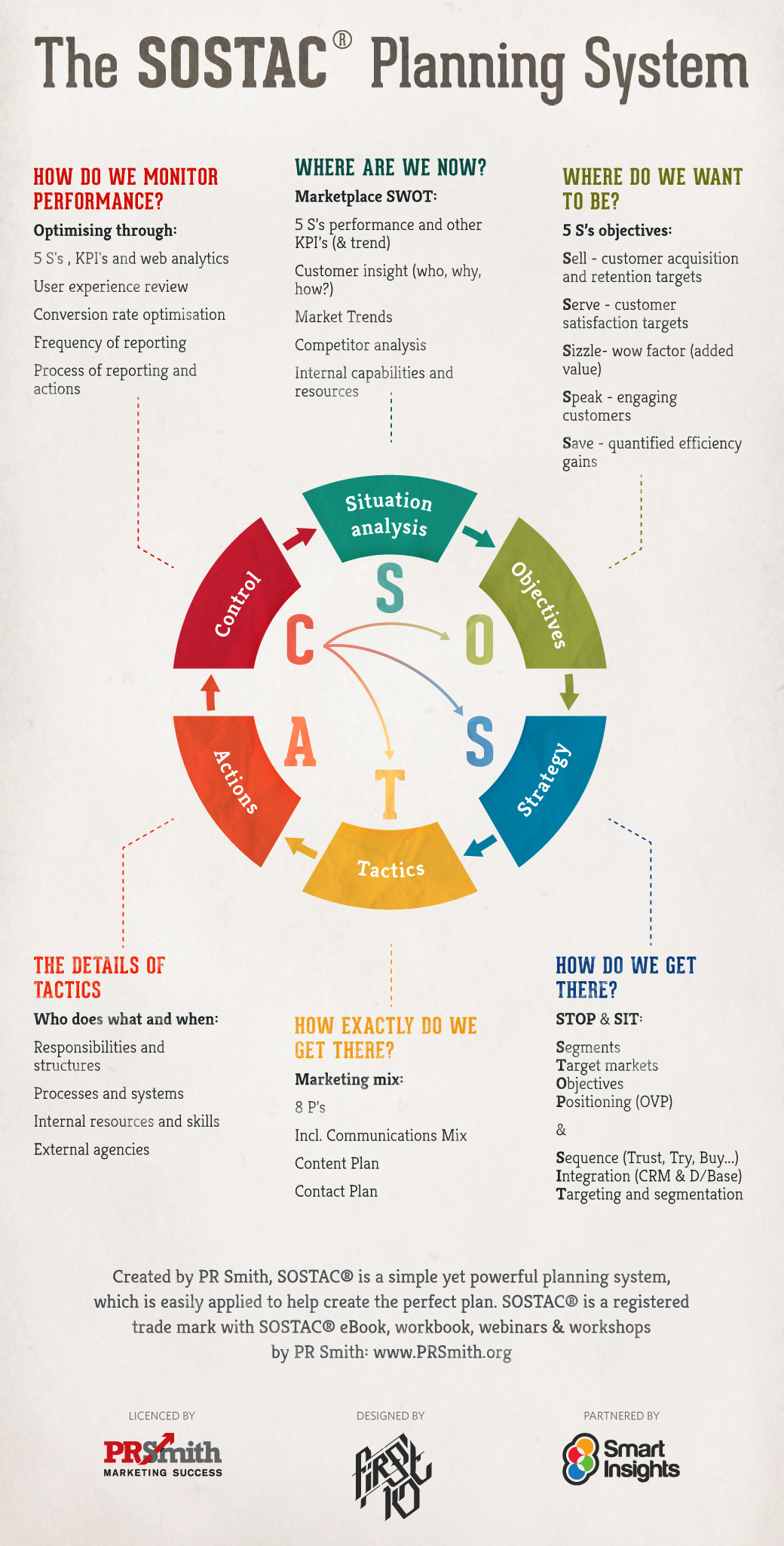If you’re involved in planning marketing campaigns and strategies than you need a framework that will help you to create marketing plans with ease.
The SOSTAC® marketing model is an easy-to-learn and highly effective planning framework that will help you to create a detailed marketing plan in 6 steps.
It can be used when creating your overall marketing or digital marketing strategy, or it can be applied to individual channels that you may be using such as PPC, Email, etc. It is easy to learn and has been voted as one of the top 3 marketing models in the world by the Chartered Institute of Marketing’s centenary poll.
What is SOSTAC®?
SOSTAC® is a marketing plan model that was created by PR Smith to provide an easy-to-follow framework for creating marketing plans.
It is an acronym that stands for:
S: Situational Analysis – Where are we now?
O: Objectives – Where do we want to be?
S: Strategy – How do we get there?
T: Tactics – How exactly do we get there?
A: Actions – What is our plan?
C: Controls – How do we monitor performance?

The SOSTAC model offers a clear and easy-to-follow logical plan that will give you a comprehensive understanding of where you are, how to get to your desired destination, and how to measure your progress and stay on track.
Let’s run through each part in more detail.
Situational Analysis – where are we now?
The first step in the model is Situational Analysis – identifying where you are now.
Before you can reach your objectives you need to know exactly where you are now and what your current situation is. A situational analysis will allow you to understand your capabilities, customers, potential customers, competitive landscape, and other external factors that may affect your market or business.
Two of the best ways to analyse your current situation are to conduct a SWOT analysis and a PESTLE analysis.
A SWOT analysis looks at the Strengths, Weaknesses, Opportunities, and Threats of your market and business. A PESTLE analysis looks at the external factors that affect your market or business. These are the Political, Environmental, Social, Technological, Legal, and Economic factors.
Another important aspect of your situational analysis is conducting a Customer analysis to get a thorough understanding of your target market and audience.
Your customer analysis should ask:
- Who are you serving?
- What are their pain points?
- What results are they looking for?
- What are their interests?
- Where do they “hangout” and congregate online?
- What channels can I use to target them?
- What sort of messaging will resonate best with them?
For a more in-depth view on customer analysis check out our post on how to identify and understand your target audience.
You also need to conduct a Competitor analysis to understand your competitive landscape:
- Who are your competitors?
- What do they do well?
- What do they not do so well?
- How do they approach their marketing?
- What strategies and tactics do they use?
Once you have conducted your analysis using the frameworks mentioned you will have a good idea of your current situation and where you are at the moment relative to the rest of the market.
Objectives – were do we want to be?
Now you know where you are, you have to identify where you want to be. What are your objectives or goals?
Dave Chaffey of Smart Insights has created the RACE model which helps to identify 4 key objectives you should be targeting. These are:
Reach: Your objectives for increasing your brand awareness, reaching more people, and increasing customer engagement.
Example: increase the number of visitors to your website by 6%
Act: Your objectives for encouraging initial interaction with your content for lead generation and capture
Example: increase email newsletter subscription opt-in by 10%
Convert: Identify your conversion goals
Example: increase online conversion rates by 7%
Engage: Identify your post-sales engagement goals to create longterm loyalty and brand advocacy
Example: generate five star reviews from 60% of existing customers
Your objectives should also be SMART – Specific, Measurable, Attainable, Realistic
Example: increase online conversion rates by 7% by next quarter, to be measured via Google Analytics.
Strategy
Your strategy is the big picture of how you will achieve the objectives you have set out. Your strategy will ultimately drive your tactics.
“All men can see the tactics whereby I conquer, what none can see is the strategy out of which victory is evolved”…….Sun Tzu, The Art Of War
STP is a model that can help you to get your strategy right. It stands for Segmentation, Targeting, and Positioning.
Your strategy should outline:
- Segmentation: How do you plan to divide your market e.g. by demographics or by lifestyle?
- Targeting: Which segments of customers you will focus on – which segments of your target market are the most viable and relevant for your business, product, or service?
- Positioning: What sort of messaging you will use to communicate with each segment of your target audience? The messaging you use will determine how should you position your product, service, or offer.
Tactics
Tactics are the details of your strategy. Whereas strategy is the big picture of how you will achieve your objectives, your tactics outline the smaller picture and deal with the specifics of how you will implement the strategy.
This section of your marketing plan outlines the specific tools, marketing channels, techniques, data sets, etc. you need to execute your strategy.
Some of your tactics may involve using SEO, PPC advertising, creating a social media content plan, having an email marketing campaign, etc. You may have different tactics to target different segments, such as using social media to target a younger audience and email marketing to target an older demographic.
Actions
This section of your plan outlines the finer details of the implementation of your tactics. This is where you outline who will be doing what, where and how they will do it, and when they will do it by.
This is where you can set your deadlines for the completion of each task, times for progress updates, and implement accountability measures. You may decide to delegate certain tactics to internal departments, or you may outsource certain tactics to an outside agency or freelancer.
By being as specific as possible you ensure that everyone involved understands their role and their task. They should know how to do what they’ve been assigned and be able to complete those actions within an agreed timescale.
Control
Once you have identified what actions need to be taken you need to ensure you can monitor performance to track and measure your progress.
This is where you identify and set your KPIs (key performance indicators) so that you can measure your progress against the goals outlined in your objectives.
Example: If one of your objectives is to increase the number of visitors to your website from your PPC campaigns by 5% then the KPIs you may choose to monitor could be impressions, impression share, share of click, number of clicks, and CTR (click-through rate) of your PPC ads.
By having these KPIs in place you will be able to easily identify if you are on track or not, and if necessary you can adjust your tactics accordingly, or delegate those tactics to someone else.
Conclusion
So there you have it, a quick overview of PR Smith’s SOSTAC® model and marketing plan framework.
By following the framework and completing each section as thoroughly as possible you will be armed with a solid marketing plan that you can begin to execute and which can be clearly communicated with your team.
The SOSTAC® model makes creating a marketing plan easy and straightforward. If you implement a marketing plan and it doesn’t entirely go to plan, go back to the drawing board and analyse which part needs to be changed.
You may have to adjust your strategy, or perhaps tweak the tactics a little. Maybe your objectives aren’t realistic enough and have to be revised. By sticking to the framework you have a clear breakdown of all parts of your plan and can make adjustments when necessary.
SOSTAC® is a registered trademark of PR Smith. For more information on SOSTAC® Planning & becoming a SOSTAC® Certified Planner visit www.SOSTAC.org




